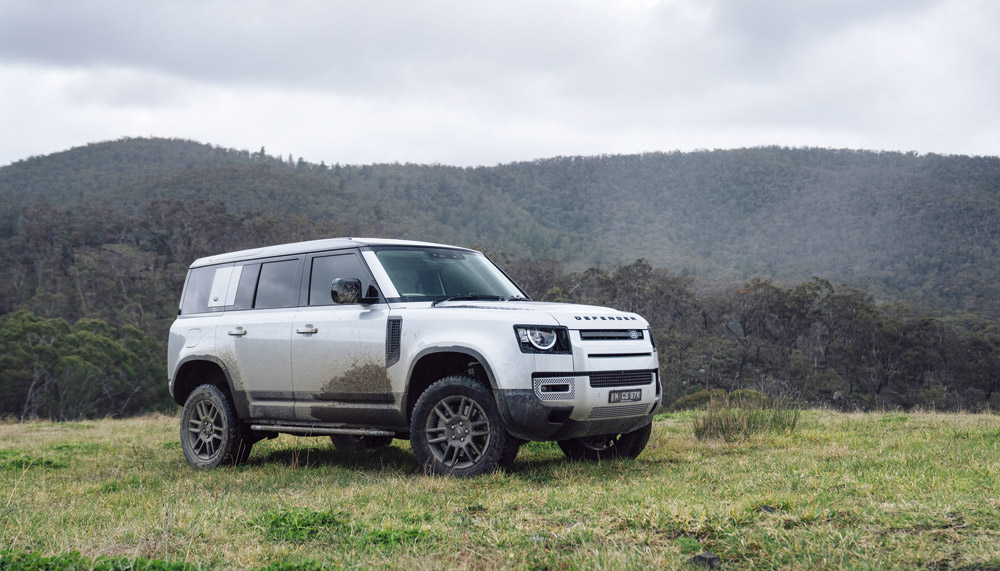Land Rover’s sophisticated new Defender powers past the farm gate.
Story Bruce McMahon
The second-generation Defender is seven decades and myriad push buttons removed from the original Land Rover.
That British 4WD – launched in 1948 – morphed into the Defender in 1990, but the basics, while updated and upgraded through the seasons, remained much the same. That meant a ladder chassis, live axles and square-rigged body with levers for various controls, plus precious few comforts in a draughty cabin with sit-up-and-beg driving style. It was always capable, just not that comfortable for day-to-day duties.
Now Land Rover has produced an all-new machine with monocoque body, independent suspension for corners, push-button technology to engage suspension and off-road settings, and a plusher, if still pragmatic, interior. The Defender badge is one of the few connections between old and new.
Family-style cues such as the checker plate on the bonnet, squared-off rear corners and skylight windows above the back seats pay homage to the wagons that went before, yet the latest Defender 110 has a hulking road presence, which well overshadows those originals, and current rivals such as Toyota’s Prado and LandCruiser. The five-door Land Rover is long, at around 5m, its length emphasised by wheels pushed out – for optimum clearance angles – to the corners of a handsome body close on 2m wide and almost 2m high.
This translates to excellent interior space, helped by a workmanlike approach to 21st century features. The cabin layout and ergonomics are clever and detailed, yet simple, from modern grab rails, huge centre console and smart dashboard spaces for oddments, through to dash-mounted gear selector for the eight-speed automatic transmission, just to the driver’s left hand. Then there is the neat array of push buttons for air conditioning and driving modes – including low range – which stay blank until the ignition is on, helping the carpetless interior retain an old-school, ready-for-the-rough feel.
This is a smart, spacious interior loaded with modern conveniences, which include infotainment unit and sockets for all manner of plugs, plus excellent head, leg and shoulder room in the first two rows of seats. There is the option of a third row of two seats, where space is a tad more limited. With those left out, or folded flat, there’s a decent amount of cargo space – almost a metre in length.
Despite the size, the Defender is an easy drive in traffic, with a range of today’s aids – from collision and lane-keeping warnings to rear-view camera. The driver sits high, with all-round vision only limited by the tailgate-mounted spare wheel at the rear.
Customers who opt for the quicker 3L petrol engine may not be that concerned about rear vision out of town because, with 294kW arriving just past 5500rpm and 500Nm of torque from 2000rpm, this Land Rover is one very rapid machine. It overtakes with confidence.
Fuel consumption on an easy highway run came in around 10L/100km. Expect high teens if the petrol Defender is worked hard. The factory claims a 0–100km/h time of 6.1 seconds and a 191km/h top speed. (The two diesel engine options should offer better economies, while the supercharged V8 option to come will offer even more performance.)
Top speed figures may be irrelevant in most situations, although these do suggest confidence that this vehicle can handle higher touring speeds than its predecessor. So, while the 4WD capability of today’s Defender is no surprise – press a button, raise the suspension for 291mm of ground clearance, then press another for one of nine drive modes from bitumen to bog – it is the highway and back road handling that is a revelation in this 2.4-tonne off-roader.
It does not, of course, have the road manners or sharpness of steering of a Jaguar sedan, yet the all-wheel-drive Land Rover has excellent grip and poise at all speeds and under all surface conditions. It turns into corners with confidence and a touch of body lean, reminiscent of early Range Rovers. It is comfortable down a rutted road, although the 20-inch wheels may find comfort limits on sharp lumps or potholes. Likewise, when suspension is raised to full height for off-road work there is not a lot of suppleness left.
This Land Rover 110 lives up to the badge and takes it well beyond the original Defender. It is stylish, sophisticated and very capable.
This story excerpt is from Issue #137
Outback Magazine: June/July 2021










